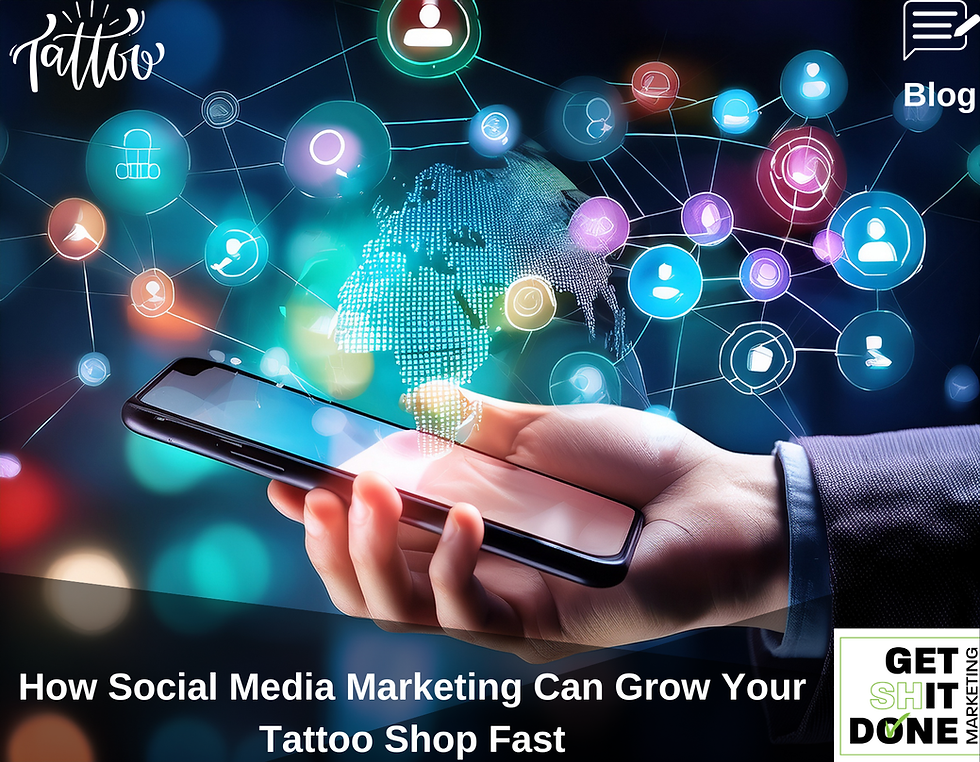How to Optimize Your Tattoo Shop Website for Local Search
- Muhammad Abubakar
- Aug 25
- 6 min read
In 2025, the success of a tattoo shop isn't just about skill with ink—it's also about how easily clients can find you online. With most people turning to Google before walking into any local business, having a strong online presence is no longer optional. Whether someone is searching for “tattoo artist near me” or browsing reviews on Google Maps, your shop’s visibility in local search results directly impacts how many new clients walk through your door. If your business doesn’t show up, potential customers will book with a competitor who does.
That’s where local SEO (Search Engine Optimization) comes in. Local SEO helps tattoo shops rank higher in search results when users look for nearby services on their phones or desktops. From optimizing your Google Business Profile to making sure your website includes city-specific keywords, local SEO ensures your shop appears in front of the right people at the right time. In a mobile-first world, this strategy is one of the most powerful tools for growing your tattoo business—and it works 24/7, even when you’re not in the studio.

What Is Local SEO and Why Tattoo Shops Need It
Local SEO is a digital marketing strategy that helps your tattoo shop show up in search results when potential clients in your area are looking for services like yours. It focuses on optimizing your online presence—especially on platforms like Google Maps and local directories—so your business appears when someone nearby searches for phrases like “tattoo artist in [your city]” or “best tattoo shop near me.” Unlike traditional SEO, which aims to reach a broad online audience, local SEO is all about targeting people in your immediate geographic area—those most likely to book an appointment.
In today’s mobile-driven world, people regularly use “near me” searches to find nearby tattoo studios, and Google automatically shows local results based on location. In fact, studies show that over 46% of all Google searches have local intent, and searches for “tattoo shops near me” have seen steady growth year over year. If your business doesn’t appear in those results, you’re missing out on a huge stream of potential walk-ins and bookings. Local SEO ensures your shop is not only visible but also competitive in your area, giving you a real edge over less-optimized studios.
Optimize Your Google Business Profile
Your Google Business Profile is one of the most powerful tools for getting your tattoo shop noticed in local search results. Once claimed, it’s crucial to fill out every section accurately—include your tattoo shop’s full name, business category (like “tattoo artist” or “tattoo studio”), operating hours, phone number, and detailed service descriptions. This information helps Google understand your business and match it to relevant local searches.
To maximize visibility, use local keywords in your service descriptions, such as “custom tattoos in [your city]” or “tattoo artist near [neighborhood name].” These phrases signal to Google what your business offers and where it's located, improving your chances of showing up in “near me” searches. Also, upload high-quality photos of your work, studio, and artists—images help convert searchers into clients. Finally, ask satisfied clients to leave 5-star reviews and always respond to them, whether positive or negative. Reviews not only build trust with potential clients but also boost your local ranking in Google’s algorithm.
On-Page SEO for Your Tattoo Website
Using local keywords throughout your website is essential for helping search engines understand what your business does and where it's located. These keywords should appear naturally on key pages like your homepage, about page, and service pages. For example, instead of just saying “We do custom tattoos,” write “We’re a custom tattoo shop in [City] specializing in black and grey realism.” You can also include phrases like “best tattoo artist near [Neighborhood]” to target more specific local searches. These small changes help Google connect your website to nearby users searching for tattoo services.
If you have more than one shop, creating separate location pages for each one can significantly improve your local visibility. Each page should include the shop’s exact address, photos of the studio, bios of the artists who work there, and customer testimonials relevant to that location. This helps search engines and clients clearly understand the difference between your locations. To take it a step further, adding local schema markup—structured data that tells Google key details about your business—can boost your site’s appearance in search results. Tools like Rank Math or Yoast SEO (for WordPress) make adding schema easy, helping your tattoo shop stand out online.
Build Local Backlinks and Citations
Submitting your tattoo shop to local directories and niche tattoo listings is a foundational step in boosting your local SEO. Start with major platforms like Google Business Profile, Yelp, Bing Places, Facebook, Apple Maps, and Tattoo.com, then expand to regional business directories and tattoo-specific forums. These are called “citations,” and having your Name, Address, and Phone number (NAP) listed consistently across all platforms helps search engines verify your business info, which directly improves your visibility in local search results.
Another powerful strategy is partnering with local influencers or lifestyle bloggers to feature your tattoo shop. Reach out to people in your city with engaged audiences and offer a free tattoo or studio tour in exchange for a blog post, video, or Instagram reel. When these local sources link back to your website, it creates high-quality local backlinks—one of the strongest signals for improving your domain authority and local search rankings. These connections not only bring in direct traffic but also build trust with both search engines and potential clients.

Make Your Website Mobile-Friendly and Fast
More than 60% of local business searches now happen on mobile devices, which means if your tattoo shop’s website isn’t mobile-friendly, you're likely losing potential clients. A responsive website design ensures your site looks great and functions smoothly on all screen sizes—from smartphones to tablets. It’s also essential to have mobile-optimized features like easy navigation, click-to-call buttons, and a fast, user-friendly booking form. If visitors can’t quickly find info or book an appointment from their phone, they’ll bounce and head to a competitor who makes it easier.
Site speed is another critical factor that directly affects both user experience and search rankings. A slow-loading website frustrates visitors and increases bounce rates, which tells Google your site isn’t meeting users’ needs. This can push your site lower in local search results. Use free tools like Google PageSpeed Insights or GTMetrix to test your site’s speed and identify what’s slowing it down. Common fixes include compressing images, reducing unnecessary plugins, and enabling browser caching. A fast, mobile-friendly site not only keeps potential clients engaged—it also helps you rank higher in local searches.
Track Your Local SEO Performance
Tracking your local SEO performance is essential to understand what’s working and where to improve. Start by setting up Google Search Console and Google Analytics—two free tools that provide deep insights into how people find and interact with your website. Search Console shows you what local keywords people are using, how often your site appears in search results (impressions), and how many times people click through to your site. Google Analytics helps you track bounce rate, session duration, and which pages are getting the most traffic, so you can optimize your content and calls to action accordingly.
In addition to website analytics, your Google Business Profile offers powerful Insights that show how customers are finding your shop—whether through direct searches, discovery searches, or by viewing your photos. You can also see what actions people take, like clicking “Call” or “Get Directions,” and which times or services get the most visibility. These insights allow you to adjust your marketing strategy, focus on high-performing services, and even plan staff schedules around peak traffic times. By regularly reviewing this data, you can make smarter decisions to grow your tattoo business.
Conclusion
Local SEO isn’t just a nice-to-have—it’s a must-have for tattoo shops looking to stay competitive and consistently attract new clients in 2025. With more people turning to Google and mobile searches to find nearby tattoo artists, optimizing your online presence ensures that your shop shows up when and where it matters most. From updating your Google Business Profile to using the right keywords and building local backlinks, every step strengthens your visibility and increases your chances of booking more appointments.
If this all sounds overwhelming, don’t stress. The key is to start small—optimize one thing at a time, and build momentum as you go. But if you’rea serious about scaling fast and don’t want to waste time guessing, it’s time to partner with a pro. At Get Shit Done Marketing
, we specialize in helping tattoo shops grow with real, no-BS marketing that works. Let’s get shit done—together.





Comments